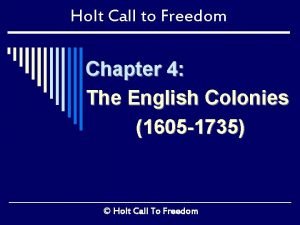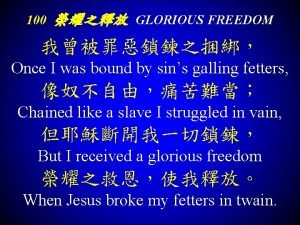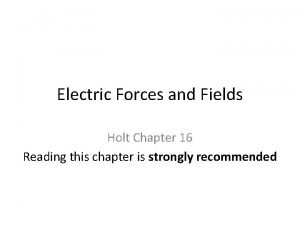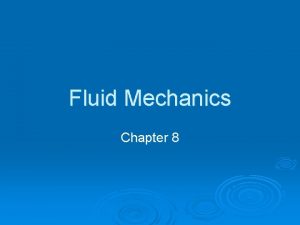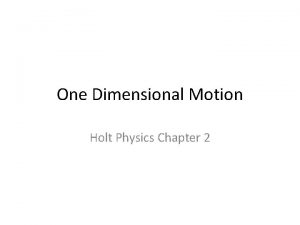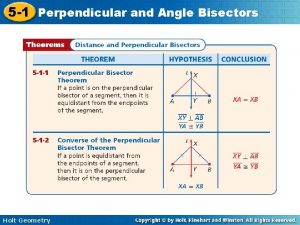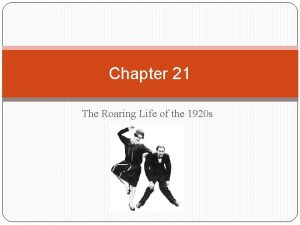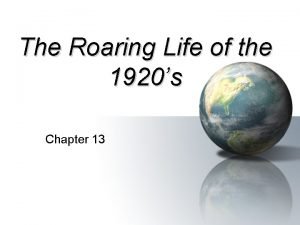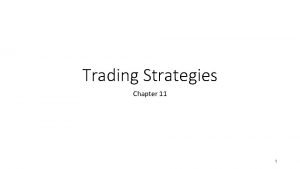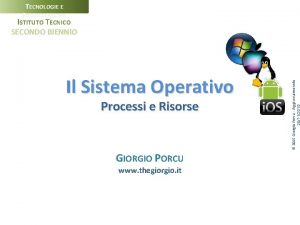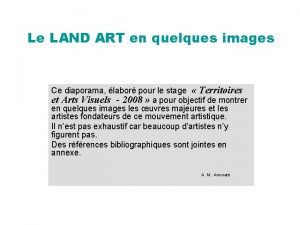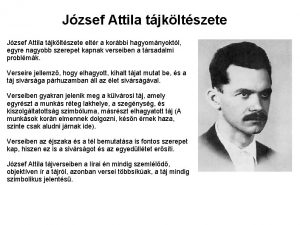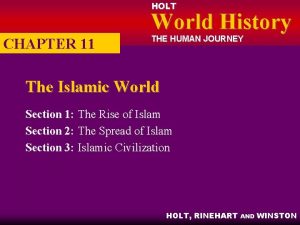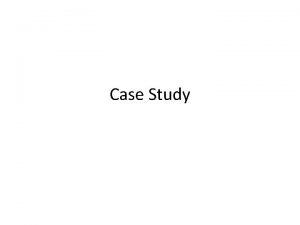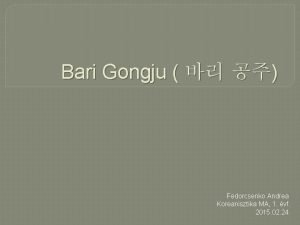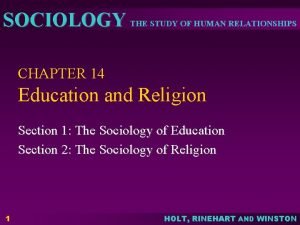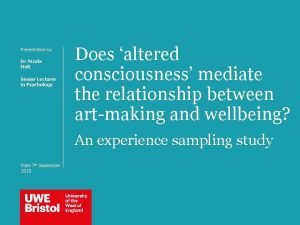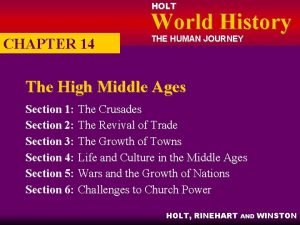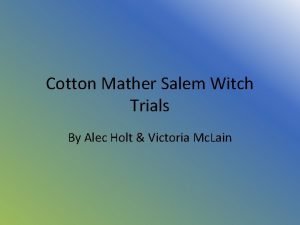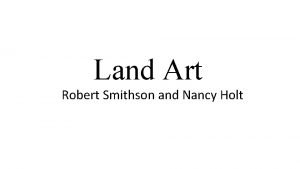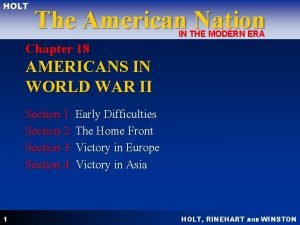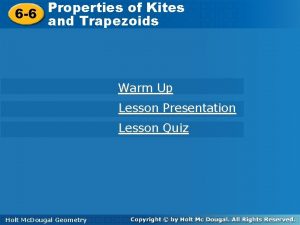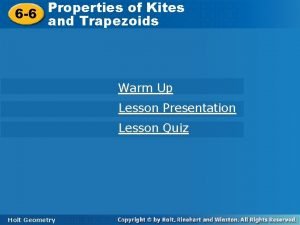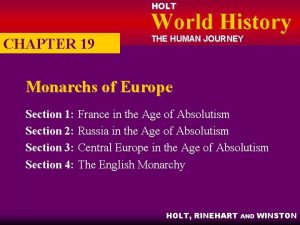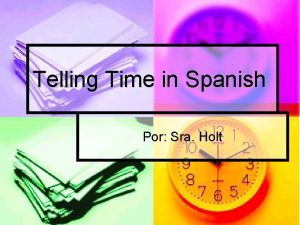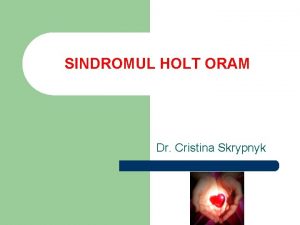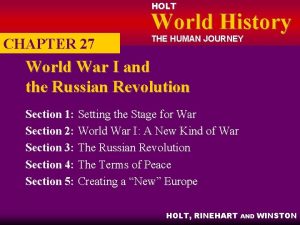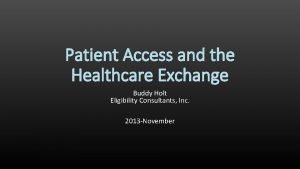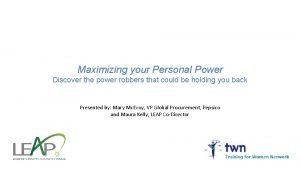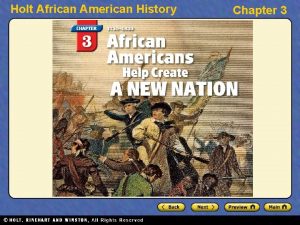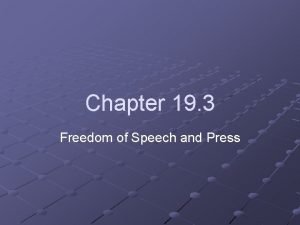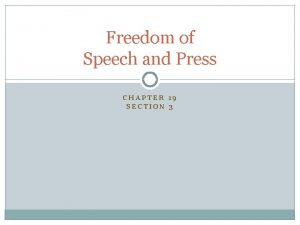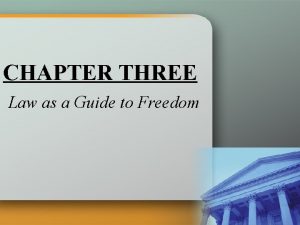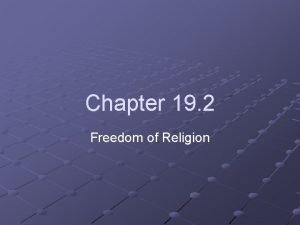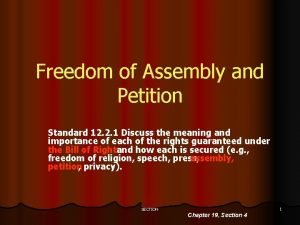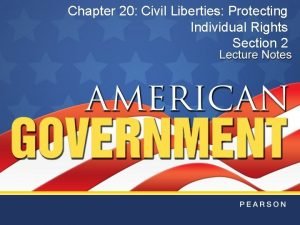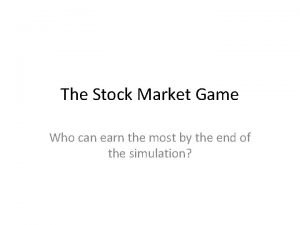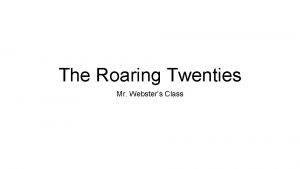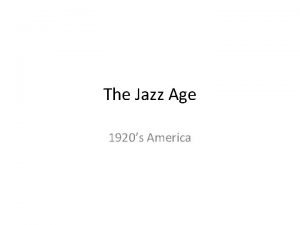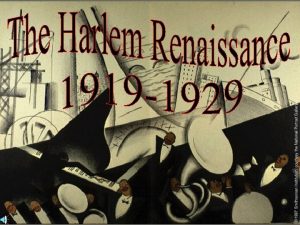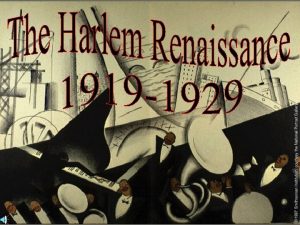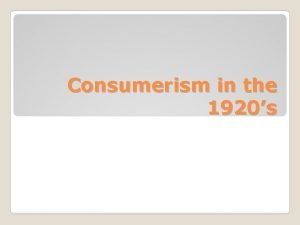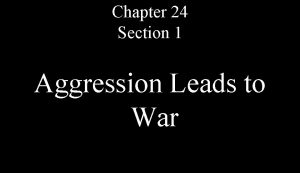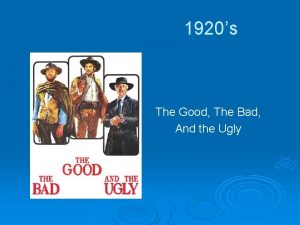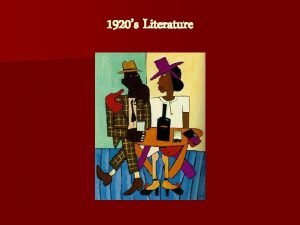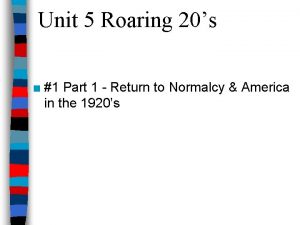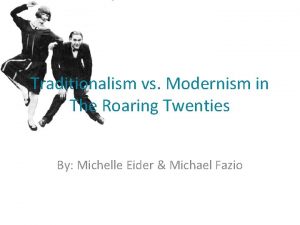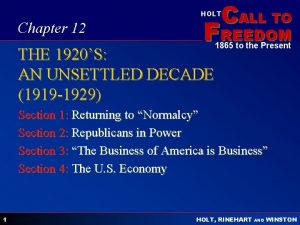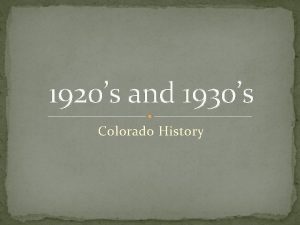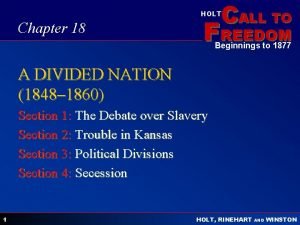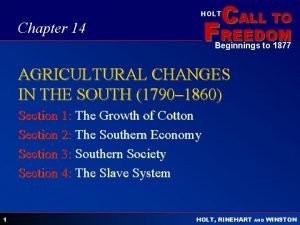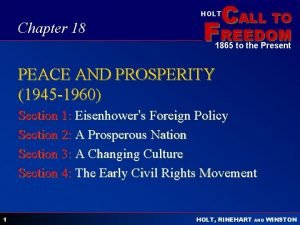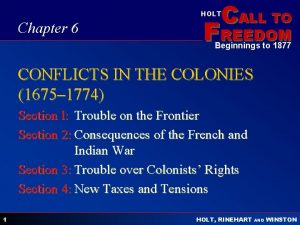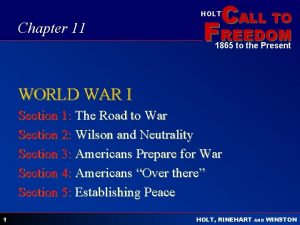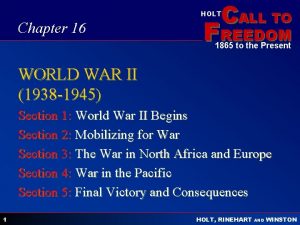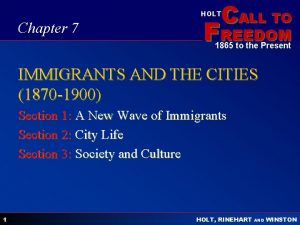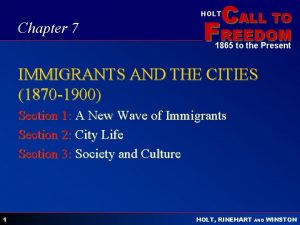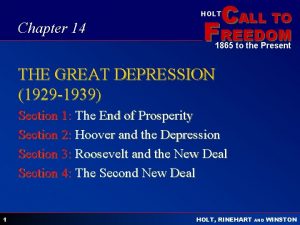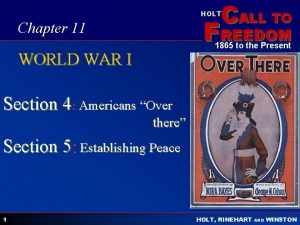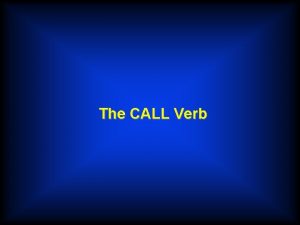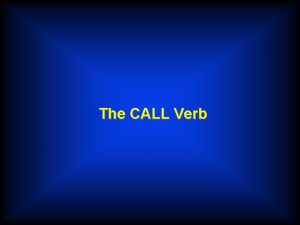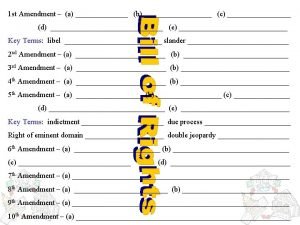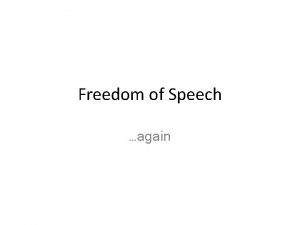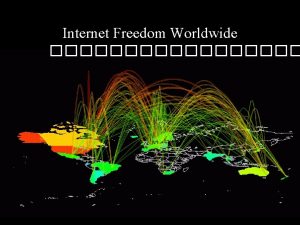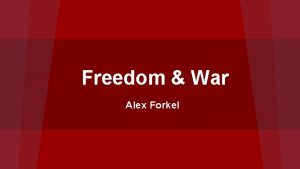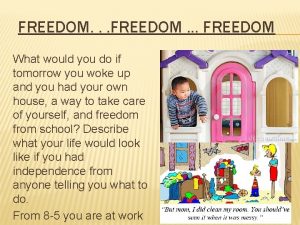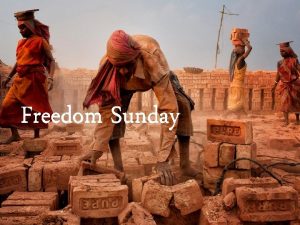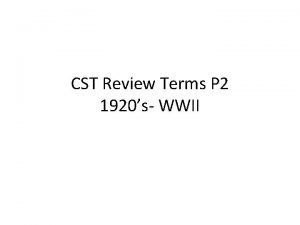CALL TO HOLT Chapter 12 FREEDOM THE 1920S



!["The same patriotism which induced [convinced] women to enter industry during the war should "The same patriotism which induced [convinced] women to enter industry during the war should](https://slidetodoc.com/presentation_image_h2/8e7ae769d5b152ac796b2e36b6e83d30/image-4.jpg)










































![CALL TO HOLT FREEDOM 1865 to the Present l "The American conception [idea] of CALL TO HOLT FREEDOM 1865 to the Present l "The American conception [idea] of](https://slidetodoc.com/presentation_image_h2/8e7ae769d5b152ac796b2e36b6e83d30/image-47.jpg)











- Slides: 58

CALL TO HOLT Chapter 12 FREEDOM THE 1920’S: AN UNSETTLED DECADE (1919 -1929) 1865 to the Present Section 1: Returning to “Normalcy” Section 2: Republicans in Power Section 3: “The Business of America is Business” Section 4: The U. S. Economy 1 HOLT, RINEHART AND WINSTON

Section 1: Returning to “Normalcy” CALL TO HOLT FREEDOM 1865 to the Present OBJECTIVES l What difficulties did the United States face when making the transition from war to peacetime? l What were some of the causes of the strikes and riots of 1919? l How did the Red Scare affect American society? 2 HOLT, RINEHART AND WINSTON

Section 1: Returning to “Normalcy” CALL TO HOLT FREEDOM 1865 to the Present Difficulties in the Transition to Peace l U. S. struggled through a period of demobilization – the process of returning to a peacetime economy. l Veterans returned home to find their jobs had been filled by others. l To make room for the men, women were forced to give up their jobs. l Business began laying off employees. l Prices and unemployment continued to rise but wages fell or stayed about the same. 3 HOLT, RINEHART AND WINSTON
![The same patriotism which induced convinced women to enter industry during the war should "The same patriotism which induced [convinced] women to enter industry during the war should](https://slidetodoc.com/presentation_image_h2/8e7ae769d5b152ac796b2e36b6e83d30/image-4.jpg)
"The same patriotism which induced [convinced] women to enter industry during the war should induce them to vacate [leave] their positions after the war. " —AFL's Central Federated Union in New York, quoted in Anxious Decades, by Michael E. Parrish 4

Section 1: Returning to “Normalcy” CALL TO HOLT FREEDOM 1865 to the Present Causes of Strikes and Riots of 1919 l Workers went on strike for better pay. l In February 1919 union workers in the shipbuilding industry went on strike in Seattle, Washington. l Demanding more pay and shorter working hours, steel workers in Pittsburgh, Pennsylvania walked off the job on September 22, 1919. l September 1919, police in Boston went on strike and the state militia was called in to restore order. 5 HOLT, RINEHART AND WINSTON

During the Seattle general strike, union leaders set up community kitchens and milk stations to feed the strikers and their families. 6 Corbis/Pemco-Webster & Stevens Collection; Museum of History & Industry, Seattle

CALL TO HOLT Police Patrol FREEDOM 1865 to the Present l During a 1919 labor strike in New Jersey, these police officers patrolled the streets. That same year police in Boston went on strike themselves. 7 HOLT, RINEHART AND WINSTON

Section 1: Returning to “Normalcy” CALL TO HOLT FREEDOM 1865 to the Present The Red Scare and American Society l Strikes and riots of 1919 led to fears that a communist revolution might occur in the U. S. leaders feared that groups that challenged the government threatened the American way of life. l Many Americans stereotyped a majority of European immigrants as being dangerous. 8 HOLT, RINEHART AND WINSTON

At the end of your notes. What some Americans were thinking? Fearing? This cartoon was published in 1919 during the Red Scare. This image of the flame labeled “Anarchy” resembles the flame of the Statue of Liberty and suggests that anarchy, or lawlessness, threatens U. S. liberty. 9

Section 1: Returning to “Normalcy” (continued) CALL TO HOLT FREEDOM 1865 to the Present The Red Scare and American Society l Public concern grew after several bombings were aimed at business and government leaders such as U. S. Attorney General A. Mitchell Palmer. l The Red Scare added to the climate of xenophobia – the fear and hatred of foreigners. 10 HOLT, RINEHART AND WINSTON

CALL TO HOLT FREEDOM 1865 to the Present 11 HOLT, RINEHART AND WINSTON

Alexander Mitchell Palmer: Attorney General 12

CALL TO HOLT Reaction to the bombings: FREEDOM 1865 to the Present l Palmer Raids: Federal agents in more than 30 cities arrested 6, 000 suspected radicals. l Hundreds of immigrants were deported and some were never charged with a crime. l Many civil rights violations (ACLU) 13 HOLT, RINEHART AND WINSTON

CALL TO HOLT FREEDOM 1865 to the Present 14 HOLT, RINEHART AND WINSTON

CALL TO HOLT FREEDOM 1865 to the Present Trial of Sacco and Vanzetti l Two Italian immigrants l Two men who were arrested in 1920. l They were charged with robbing a Massachusetts shoe factory and murdering the payroll clerk and guard. 15 HOLT, RINEHART AND WINSTON

CALL TO HOLT Crime Scene Map FREEDOM 1865 to the Present l Both men said they were somewhere else when the crimes were committed. They had alibis. 16 HOLT, RINEHART AND WINSTON

CALL TO HOLT FREEDOM 1865 to the Present The trial of Sacco and Vanzetti l Sacco and Vanzetti were anarchists, and their political background made people suspicious. l Many observers considered the trial unfair because the judge allowed questions about their political beliefs. l Sacco and Vanzetti were executed in 1927. 17 HOLT, RINEHART AND WINSTON

CALL TO HOLT FREEDOM 1865 to the Present l Vanzetti on the left; Sacco on the right. Notice the handcuffs. 18 HOLT, RINEHART AND WINSTON

CALL TO HOLT FREEDOM 1865 to the Present 19 HOLT, RINEHART AND WINSTON

Protests on behalf of the two accused. 20

CALL TO HOLT FREEDOM 1865 to the Present l Ben Shahn created this poster to protest the execution of Bartolomeo Vanzetti and Nicolo Sacco who were electrocuted in 1927. He chose as the text a statement Vanzetti made to a reporter shortly before their deaths. 21 HOLT, RINEHART AND WINSTON

CALL TO HOLT FREEDOM 1865 to the Present l What many thought was an unfair trial; victims of the Red Scare of the 1920 s. 22 HOLT, RINEHART AND WINSTON

23

Finding the Main Idea l What began the Red Scare? How did it effect Americans? _____________________________________ _____________________________________ ___________________ 24

Section 2: Republicans in Power CALL TO HOLT FREEDOM 1865 to the Present OBJECTIVES l How did the Harding and Coolidge administration address economic issues? l What foreign policy did the United States follow during the 1920’s? l Why did Republicans win the presidential elections of the 1920’s? 25 HOLT, RINEHART AND WINSTON

CALL TO HOLT Harding and Coolidge 26 29 th & FREEDOM 1865 to the Present th 30 President HOLT, RINEHART AND WINSTON

27

Section 2: Republicans in Power CALL TO HOLT FREEDOM 1865 to the Present Harding and Coolidge and the Economy l l l Both were pro-business. They supported aid to farmers. Congress passed many tax cuts under Coolidge. l Harding kept government spending to a minimum and favored low taxes, low interest rates on loans, high tariffs, and little economic regulation. 28 HOLT, RINEHART AND WINSTON

Section 2: Republicans in Power CALL TO HOLT FREEDOM 1865 to the Present U. S. Foreign Policy in the 1920’s l The U. S. promoted peace and economic growth abroad. l Diplomats hoped that new treaties would prevent another world war and make the global economy stronger. l The U. S. supported disarmament – the practice of limiting military weapons. 29 HOLT, RINEHART AND WINSTON

Section 2: Republicans in Power (continued) CALL TO HOLT FREEDOM 1865 to the Present U. S. Foreign Policy in the 1920’s l At the Washington Conference (1921), the U. S. and other countries signed the Five. Power Naval Treaty, which limited the maximum size of each country’s Navy. l In August 1928, the U. S. and 14 other countries signed the Kellogg-Briand Pact, which tried to outlaw war. 30 HOLT, RINEHART AND WINSTON

Section 2: Republicans in Power CALL TO HOLT FREEDOM 1865 to the Present Republicans Win the Election of 1928 l Candidates reflected the growing political differences between rural and urban America. l Protestants opposed Democratic candidate Alfred E. Smith because he was Catholic. l Republican candidate Herbert Hoover seemed to represent traditional values and was linked to the country’s economic success. 31 HOLT, RINEHART AND WINSTON

CALL TO HOLT FREEDOM 1865 to the Present Alfred E. Smith & Herbert Hoover 32 HOLT, RINEHART AND WINSTON

Finding the Main Idea… l What steps did presidents Harding and Coolidge take to improve the national economy? _____________________________________ _____________________________________ 33

CALL TO HOLT FREEDOM 1865 to the Present Assignment: l 1. Complete Political Cartoon Questions. l 2. Complete “Red Scare” Graphic Organizer on back by answering HOW each event was influenced by the Red Scare. Give examples. 34 HOLT, RINEHART AND WINSTON

Section 3: “The Business of America is Business” CALL TO HOLT FREEDOM 1865 to the Present OBJECTIVES l How did the assembly line affect manufacturing? l What effect did the automobile have on the economy and people’s everyday lives? l How did advertising and installment plans change people’s buying habits? 35 HOLT, RINEHART AND WINSTON

Section 3: “The Business of America is Business” CALL TO HOLT F REEDOM The Assembly Line and Manufacturing 1865 to the Present 36 l The assembly line was a faster method of building cars used in Henry Ford’s automobile factory. l It moved quickly because each person did one simple task repeatedly. l The assembly line benefited business owners by saving time and lowering manufacturing costs. l The stress of assembly line jobs caused workers to quit on a regular basis leading to retraining expenses for manufacturers. HOLT, RINEHART AND WINSTON

CALL TO HOLT FREEDOM 1865 to the Present Stress on the job…. l "The weight of a tack. . . is insignificant, but if you have to drive eight tacks in every Ford cushion that goes by your station within a certain time, and [you] know that if you fail to do it you are going to tie up the entire platform, and you continue to do this for four years, you are going to break under the strain. " l —Anonymous assembly-line worker, quoted in Who Built America? , Vol. 2, edited by Joshua Freeman et al. 37 HOLT, RINEHART AND WINSTON

CALL TO HOLT F REEDOM Assembly line of 1920 1865 to the Present 38 HOLT, RINEHART AND WINSTON

CALL TO HOLT FREEDOM 1865 to the Present 39 HOLT, RINEHART AND WINSTON

Henry Ford and the Model T l Henry Ford founded the Ford Motor Co. in 1903. l Fondly called the Tin Lizzie, the Model T was not fancy, and came only in black. l The Model T could be driven on any surface. 40

41

The Model T: AKA The Tin Lizzie 42

CALL TO HOLT FREEDOM 1865 to the Present $Cost of the Model T$ l The cost of a Model T fell from $850 in 1908 to $290 in 1927. l By 1921 Ford controlled some 55% of the American market and was selling more than 1 million cars a year. 43 HOLT, RINEHART AND WINSTON

Section 3: “The Business of America is Business” CALL TO HOLT FREEDOM 1865 to the Present Effects of the Automobile on the Economy and People’s Lives l The automobile supplied the public with inexpensive transportation. l Millions of workers held jobs that supported automobile manufacturing. l Automobiles changed the landscape of America with the building of new communities. 44 HOLT, RINEHART AND WINSTON

Section 3: “The Business of America is Business” (continued) CALL TO HOLT FREEDOM 1865 to the Present Effects of the Automobile on the Economy and People’s Lives l Federal and state governments funded bridge, highway and tunnel construction projects. l Families began taking driving vacations and roadside businesses developed. 45 HOLT, RINEHART AND WINSTON

Section 3: “The Business of America is Business” CALL TO HOLT FREEDOM 1865 to the Present Advertising and Installment Buying and the Consumer l The birth of new products led to a boom in advertising and installment buying. l Advertisers helped create nationally known brand names and encouraged people to buy products. l Advertisements promised Americans more leisure time. 46 HOLT, RINEHART AND WINSTON
![CALL TO HOLT FREEDOM 1865 to the Present l The American conception idea of CALL TO HOLT FREEDOM 1865 to the Present l "The American conception [idea] of](https://slidetodoc.com/presentation_image_h2/8e7ae769d5b152ac796b2e36b6e83d30/image-47.jpg)
CALL TO HOLT FREEDOM 1865 to the Present l "The American conception [idea] of advertising is to arouse desires and stimulate wants, to make people dissatisfied with the old and out-of-date. . . to send them out to work harder to get the latest model—whether that model be an icebox or a rug, or a new home. " l —Bruce Barton, quoted in Fables of Abundance, by Jackson Lears 47 HOLT, RINEHART AND WINSTON

Section 3: “The Business of America is Business” (continued) CALL TO HOLT FREEDOM 1865 to the Present Advertising and Installment Buying and the Consumer l Installment plans allowed people to buy goods that had once been out of their reach. installment plans – program that allowed customers to buy goods making a small down payment followed by additional monthly payments with interest 48 HOLT, RINEHART AND WINSTON

CALL TO HOLT Reading Check FREEDOM 1865 to the Present l Answer the following question. l How did the widespread use of cars help the US economy and change American life? __________________________________________ _____________________ 49 HOLT, RINEHART AND WINSTON

Section 4: The U. S. Economy OBJECTIVES CALL TO HOLT FREEDOM 1865 to the Present l What caused the stock market boom in the 1920’s? l What were the characteristics of “sick industries” in the 1920’s? l What difficulties did organized labor and the agricultural industry experience during the 1920’s? 50 HOLT, RINEHART AND WINSTON

51

Section 4: The U. S. Economy CALL TO HOLT FREEDOM 1865 to the Present Causes of the Stock Market Boom in the 1920’s l Government’s pro-business policies and the 1920 s production led to increased profits for many companies. l From 1923 -1928 stock sales on the New York Stock Exchange increased by nearly 400 percent as Americans dreamed of great wealth. 52 HOLT, RINEHART AND WINSTON

Section 4: The U. S. Economy (continued) CALL TO HOLT FREEDOM 1865 to the Present Causes of the Stock Market Boom in the 1920’s l People borrowed money to buy stock. l Business owners, such as J. C. Penny who owned a chain of department stores, offered stock options to managers. 53 l JCPenney was founded in 1902 by James Cash Penney l and William Henry Mc. Manus HOLT, RINEHART AND WINSTON

Section 4: The U. S. Economy CALL TO HOLT FREEDOM 1865 to the Present Characteristics of “Sick Industries” l "Sick industries" did not share in the nation’s prosperity and struggled. l They were slow or unable to adapt to changing technology and consumer demand. l Struggling industries included coal, lumber and textiles whose products were being replaced with more modern materials. 54 HOLT, RINEHART AND WINSTON

CALL TO HOLT FREEDOM 1865 to the Present Sick or Struggling Industries of the 1920 s 55 HOLT, RINEHART AND WINSTON

Section 4: The U. S. Economy CALL TO HOLT FREEDOM 1865 to the Present Difficulties of Organized Labor and Agriculture During the 1920’s l l l Unions lost government support in peacetime. Businesses stopped hiring union workers. Violent strikes of 1919 had led to strong antiunion feelings. l Union membership dropped and many industries became “closed shops” where only union members could work. 56 HOLT, RINEHART AND WINSTON

CALL TO HOLT FREEDOM 1865 to the Present l The drop in agricultural prices following World War I meant hard times for many farm families. 57 HOLT, RINEHART AND WINSTON

Section 4: The U. S. Economy (continued) CALL TO HOLT FREEDOM 1865 to the Present Difficulties of Organized Labor and Agriculture During the 1920’s l With the end of war, farmer’s supply was higher than demand. l Food prices dropped and farmers could not pay their debts and lost their land. l Republican leaders did not want to interfere with the free-enterprise system by regulating farm prices. 58 HOLT, RINEHART AND WINSTON
 Holt call to freedom
Holt call to freedom Positive freedom negative freedom
Positive freedom negative freedom Glorious freedom wonderful freedom
Glorious freedom wonderful freedom Direction of dipole moment
Direction of dipole moment Buoyancy force in fluid mechanics
Buoyancy force in fluid mechanics The sears tower in chicago is 443 m tall. suppose a book
The sears tower in chicago is 443 m tall. suppose a book 5-3 perpendicular and angle bisectors
5-3 perpendicular and angle bisectors Chapter 13 the roaring life of the 1920s
Chapter 13 the roaring life of the 1920s Chapter 13 the roaring life of the 1920s
Chapter 13 the roaring life of the 1920s Protective put diagram
Protective put diagram What is options
What is options Gartner call recording magic quadrant
Gartner call recording magic quadrant Grafico di holt
Grafico di holt Hobbs and holt 1976
Hobbs and holt 1976 Token economy in psychology
Token economy in psychology Robert smithson oeuvre
Robert smithson oeuvre József attila éjszaka versek
József attila éjszaka versek Holt world history the human journey
Holt world history the human journey Gayne corporation's contribution margin ratio
Gayne corporation's contribution margin ratio Koreanisztika
Koreanisztika Amelia holt
Amelia holt Sociology the study of human relationships
Sociology the study of human relationships Nicola holt uwe
Nicola holt uwe World history the human journey
World history the human journey Alec holt
Alec holt Nancy holt robert smithson
Nancy holt robert smithson Holt world geography today
Holt world geography today Holt american nation
Holt american nation Calley travis
Calley travis Properties of kites
Properties of kites 6-6 properties of kites and trapezoids
6-6 properties of kites and trapezoids Notes 6-6 properties of kites and trapezoids
Notes 6-6 properties of kites and trapezoids Holt world history the human journey
Holt world history the human journey Holt spanish
Holt spanish Holt oram
Holt oram Ane holt
Ane holt Holt world history the human journey
Holt world history the human journey Buddy holt
Buddy holt Personal power statement
Personal power statement Holt african american history
Holt african american history Chapter 19 section 3 freedom of speech and press
Chapter 19 section 3 freedom of speech and press Chapter 19 section 3 freedom of speech and press
Chapter 19 section 3 freedom of speech and press Philosophy freedom and responsibility
Philosophy freedom and responsibility Chapter 19 section 2 freedom of religion
Chapter 19 section 2 freedom of religion Chapter 19 section 4 freedom of assembly and petition
Chapter 19 section 4 freedom of assembly and petition Chapter 20 section 2 freedom and security of the person
Chapter 20 section 2 freedom and security of the person 1920s stock market simulation
1920s stock market simulation Florida land boom of the 1920s
Florida land boom of the 1920s Jazz 1920s america
Jazz 1920s america Harlem renaissance map
Harlem renaissance map Map of harlem 1920s
Map of harlem 1920s Consumerism in the 1920s
Consumerism in the 1920s Aggressive actions taken in the 1920s and 1930s
Aggressive actions taken in the 1920s and 1930s Was the 1920s good or bad
Was the 1920s good or bad 1920s literature
1920s literature Sports mania in the 1920s
Sports mania in the 1920s Traditionalism vs modernism in the 1920s
Traditionalism vs modernism in the 1920s Which identifies two effects of the harlem renaissance?
Which identifies two effects of the harlem renaissance? Why did the kkk reemerge in the 1920s
Why did the kkk reemerge in the 1920s
